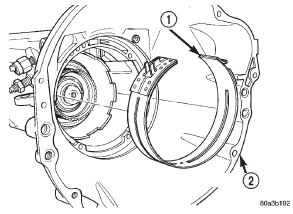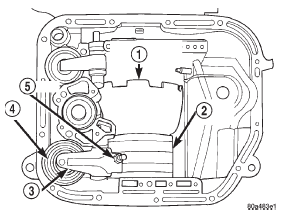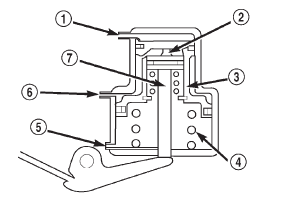Jeep Cherokee (XJ): Bands. Servos. Governor
DESCRIPTION KICKDOWN (FRONT) BAND The kickdown, or "front", band (Fig. 47) holds the
common sun gear of the planetary gear sets. The
front (kickdown) band is made of steel, and faced on
its inner circumference with a friction-type lining.
One end of the band is anchored to the transmission
case, and the other is acted on with a pushing force
by a servo piston. The front band is a single-wrap
design (the band does not completely encompass/
wrap the drum that it holds).
1 - FRONT BAND LOW/REVERSE (REAR) BAND The low/reverse band, or "rear", band (Fig. 48) is
similar in appearance and operation to the front
band. The rear band of the 32RH is slightly different
in that it does not use a link bar, but is acted directly
on by the apply lever. This is referred to as a double-
wrap band design (the drum is completely encompassed/
wrapped by the band). The double-wrap band
provides a greater holding power in comparison to
the single-wrap design. OPERATION KICKDOWN (FRONT) BAND The kickdown band holds the common sun gear of
the planetary gear sets by applying and holding the
front clutch retainer, which is splined to the sun gear
driving shell, and in turn splined directly to the sun
gear. The application of the band by the servo is typically
done by an apply lever and link bar.
1 - PLANETARY GEARTRAIN LOW/REVERSE (REAR) BAND The rear band holds the rear planet carrier stationary
by being mounted around and applied to the
low/reverse drum. DESCRIPTION KICKDOWN (FRONT) SERVO The kickdown servo (Fig. 49) consists of a two-land
piston with an inner piston, a piston rod and guide,
and a return spring. The dual-land piston uses seal
rings on its outer diameters and an O-ring for the
inner piston. LOW/REVERSE (REAR) SERVO The rear (low/reverse) servo consists of a single
stage or diameter piston and a spring loaded plug.
The spring is used to cushion the application of the
rear (low/reverse) band. OPERATION KICKDOWN (FRONT) SERVO The application of the piston is accomplished by
applying pressure between the two lands of the piston.
The pressure acts against the larger lower land
to push the piston downward, allowing the piston rod
to extend though its guide against the apply lever.
Release of the servo at the 2-3 upshift is accomplished
by a combination of spring and line pressure,
acting on the bottom of the larger land of the piston.
1 - VENT The small piston is used to cushion the application of
the band by bleeding oil through a small orifice in
the larger piston. The release timing of the kickdown
servo is very important to obtain a smooth but firm
shift. The release has to be very quick, just as the
front clutch application is taking place. Otherwise,
engine runaway or a shift hesitation will occur. To
accomplish this, the band retains its holding capacity
until the front clutch is applied, giving a small
amount of overlap between them. LOW/REVERSE (REAR) SERVO While in the de-energized state (no pressure
applied), the piston is held up in its bore by the piston
spring. The plug is held down in its bore, in the
piston, by the plug spring. When pressure is applied
to the top of the piston, the plug is forced down in its
bore, taking up any clearance. As the piston moves, it
causes the plug spring to compress, and the piston
moves down over the plug. The piston continues to
move down until it hits the shoulder of the plug and
fully applies the band. The period of time from the
initial application, until the piston is against the
shoulder of the plug, represents a reduced shocking
of the band that cushions the shift. DESCRIPTION The governor (Fig. 50) valve body is attached to
the output shaft of the transmission. OPERATION The governor meters hydraulic pressure (Fig. 51), and
this metered pressure is used to signal the transmission
when it is time for a shift to occur. It does this by balancing
governor pressure on one side of a shift valve,
and throttle pressure on the other. When governor pressure
increases far enough to overcome the throttle pressure
on the valve, a shift occurs.
With the gearshift selector in a forward driving
range, line pressure flows from the manual valve and
down to the governor valve. When the output shaft
starts to rotate with vehicle motion (Fig. 52), the governor
weight assembly will start to move outward
due to centrifugal force. As the weight is moved outward,
it will pull the valve with it until the land of
the valve uncovers the line pressure port. As the port
begins to become uncovered, governor pressure is
metered. As the vehicle's speed continues to increase
(Fig. 53), the weight assembly will be at a point at
which governor pressure is acting on the left side of
the reaction area of the valve. This produces sufficient
force to compress the spring and allow the
outer weight to move out against the outer governor
body retaining ring. At a very high speed, the governor
valve will be opened as far as possible. In this
condition, it is possible for governor pressure to meet,
but not to exceed, line pressure. Generally governor
pressure ranges from 0-100 psi from idle to maximum
speed, and rises proportionally with the
increase in output shaft speed. Governor pressure
and throttle pressure are acting upon the shift valves
to determine when a shift will occur. Governor pressure
is a direct indication of road speed, and throttle
pressure is an indication of engine load. When both
parameters have been met by the throttle and governor
pressures, an upshift or downshift will occur.Bands

Fig. 47 Front Band
2 - TRANSMISSION HOUSING
Fig. 48 Rear Band
2 - REAR BAND
3 - LEVER
4 - SERVO
5 - ADJUSTERServos

Fig. 49 Front Servo
2 - INNER PISTON
3 - PISTON
4 - SPRING
5 - RELEASE PRESSURE
6 - APPLY PRESSURE
7 - PISTON RODGovernor
 Rear clutch. Overrunning clutch. Planetary gearset
Rear clutch. Overrunning clutch. Planetary gearset
 Gearshift mechanism. Converter drainback valve. Brake transmission shift interlock
mechanism
Gearshift mechanism. Converter drainback valve. Brake transmission shift interlock
mechanism
Other materials:
Ignition coil-4.0L engine. Crankshaft position (CKP) sensor. Camshaft position sensor-2.5L
engine
Ignition coil-4.0L engine
REMOVAL
A one-piece coil rail assembly containing three
individual coils is used on the 4.0L engine (Fig. 21).
The coil rail must be replaced as one assembly. The
bottom of the coil is equipped with 6 individual rubber
boots (Fig. 21) to seal the 6 spark plugs to the ...
